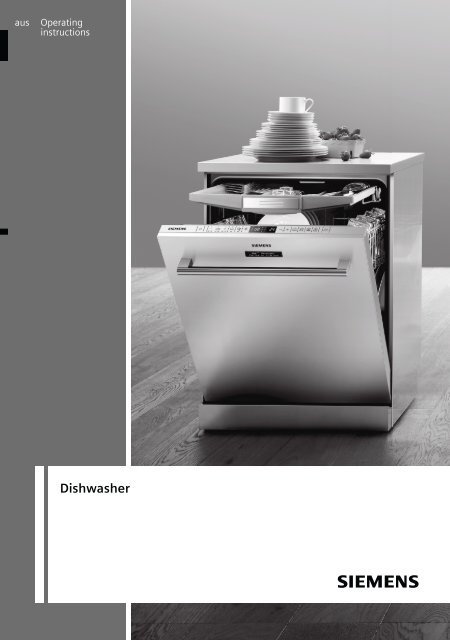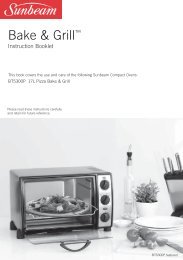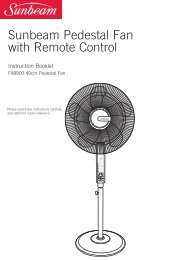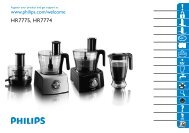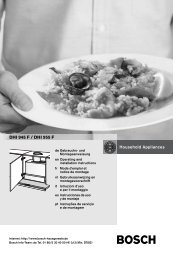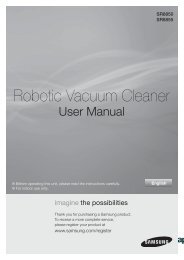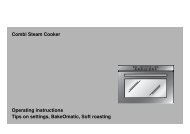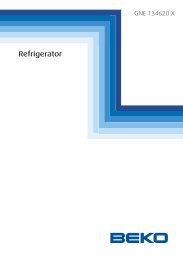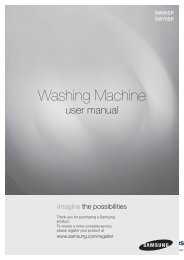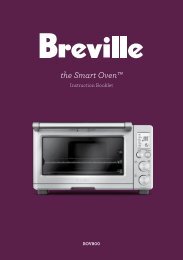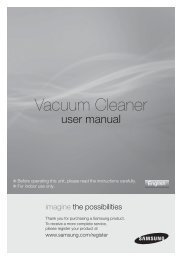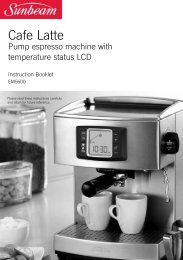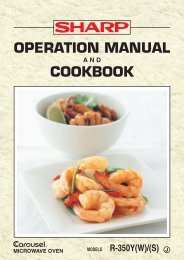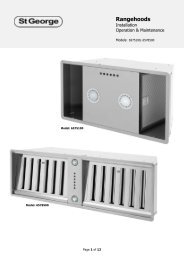Dishwasher - Appliances Online
Dishwasher - Appliances Online
Dishwasher - Appliances Online
Create successful ePaper yourself
Turn your PDF publications into a flip-book with our unique Google optimized e-Paper software.
aus Table of contents<br />
Safety instructions . . . . . . . . . . . . . . . . . 4<br />
Before you switch ON the appliance . . 4<br />
Delivery . . . . . . . . . . . . . . . . . . . . . . . . 4<br />
Installation . . . . . . . . . . . . . . . . . . . . . . 4<br />
In daily use . . . . . . . . . . . . . . . . . . . . . 4<br />
Children in the household . . . . . . . . . . 4<br />
Door lock . . . . . . . . . . . . . . . . . . . . . . 4<br />
Damage . . . . . . . . . . . . . . . . . . . . . . . 5<br />
Disposal . . . . . . . . . . . . . . . . . . . . . . . 5<br />
Getting to know your appliance . . . . . . 5<br />
Control panel . . . . . . . . . . . . . . . . . . . 5<br />
Appliance interior . . . . . . . . . . . . . . . . 5<br />
Rinse aid % . . . . . . . . . . . . . . . . . . . . . . . 6<br />
Setting amount of rinse aid . . . . . . . . . 6<br />
Switching off rinse aid refill indicator . . 6<br />
Utensils . . . . . . . . . . . . . . . . . . . . . . . . . . 7<br />
Not suitable . . . . . . . . . . . . . . . . . . . . . 7<br />
Glass and utensil damage . . . . . . . . . 7<br />
Loading the dishwasher . . . . . . . . . . . 7<br />
Unloading the dishwasher . . . . . . . . . 7<br />
Cups and glasses . . . . . . . . . . . . . . . . 7<br />
Pans . . . . . . . . . . . . . . . . . . . . . . . . . . 7<br />
Cutlery drawer . . . . . . . . . . . . . . . . . . . 8<br />
Cutlery basket . . . . . . . . . . . . . . . . . . . 8<br />
Folding spikes . . . . . . . . . . . . . . . . . . 8<br />
Small accessories holder . . . . . . . . . . 8<br />
Adjusting the height of the basket . . . 9<br />
Detergent . . . . . . . . . . . . . . . . . . . . . . . . . 9<br />
Adding detergent . . . . . . . . . . . . . . . 10<br />
Overview of programmes . . . . . . . . . . 11<br />
Programme selection . . . . . . . . . . . . 12<br />
Information for test institutes . . . . . . . 12<br />
Additional options . . . . . . . . . . . . . . . . 12<br />
VarioSpeed . . . . . . . . . . . . . . . . . . . . 12<br />
Half load . . . . . . . . . . . . . . . . . . . . . . 12<br />
Hygiene . . . . . . . . . . . . . . . . . . . . . . . 12<br />
Intensive zone . . . . . . . . . . . . . . . . . . 12<br />
Extra drying . . . . . . . . . . . . . . . . . . . . 12<br />
Washing the dishes . . . . . . . . . . . . . . . 13<br />
Programme data . . . . . . . . . . . . . . . . 13<br />
Aqua sensor . . . . . . . . . . . . . . . . . . . 13<br />
Switching on the appliance . . . . . . . . 13<br />
Remaining running time display . . . . 13<br />
Timer programming . . . . . . . . . . . . . . 13<br />
End of programme . . . . . . . . . . . . . . 13<br />
Switching off automatically after<br />
the end of the programme . . . . . . . . . 14<br />
Switching off the appliance . . . . . . . . 14<br />
Interrupting the programme . . . . . . . . 14<br />
Terminating the programme . . . . . . . 14<br />
Changing the programme . . . . . . . . . 14<br />
Intensive drying . . . . . . . . . . . . . . . . . 15<br />
Maintenance and care . . . . . . . . . . . . . 15<br />
Overall condition of the machine . . . . 15<br />
Rinse aid . . . . . . . . . . . . . . . . . . . . . . 15<br />
Filters . . . . . . . . . . . . . . . . . . . . . . . . . 16<br />
Spray arms . . . . . . . . . . . . . . . . . . . . 16<br />
Troubleshooting . . . . . . . . . . . . . . . . . . 17<br />
Waste water pump . . . . . . . . . . . . . . . 17<br />
... when the appliance is switched on 17<br />
... on the appliance . . . . . . . . . . . . . . 18<br />
... during the wash cycle . . . . . . . . . . 18<br />
... on the utensils . . . . . . . . . . . . . . . . 19<br />
Customer service . . . . . . . . . . . . . . . . 19<br />
Installation . . . . . . . . . . . . . . . . . . . . . . 20<br />
Safety instructions . . . . . . . . . . . . . . . 20<br />
Delivery . . . . . . . . . . . . . . . . . . . . . . . 20<br />
Technical specifications . . . . . . . . . . . 20<br />
Installation . . . . . . . . . . . . . . . . . . . . . 21<br />
Waste-water connection . . . . . . . . . . . 21<br />
Fresh water connection . . . . . . . . . . . 21<br />
Electrical connection . . . . . . . . . . . . . 21<br />
Removing the appliance . . . . . . . . . . 21<br />
Transportation . . . . . . . . . . . . . . . . . . 22<br />
Protection against frost<br />
(Emptying the appliance) . . . . . . . . . . 22<br />
Waste disposal . . . . . . . . . . . . . . . . . . . 22<br />
Packaging . . . . . . . . . . . . . . . . . . . . . 22<br />
Old appliances . . . . . . . . . . . . . . . . . 22
aus<br />
Safety instructions<br />
Before you switch ON<br />
the appliance<br />
Please read the operating and installation<br />
instructions carefully. They contain<br />
important information on how to install, use<br />
and maintain the appliance.<br />
Retain all documents for subsequent use<br />
or for the next owner.<br />
Delivery<br />
– Check the packaging and dishwasher<br />
immediately for damage caused in<br />
transit. Do not switch on a damaged<br />
appliance, but contact your supplier.<br />
– Please dispose of the packaging<br />
material in an environmentally friendly<br />
manner.<br />
– Do not let children play with packaging<br />
and its parts. There is a risk of<br />
suffocation from collapsible boxes and<br />
film.<br />
Installation<br />
Read the “Installation” chapter to learn<br />
how to install and connect the appliance<br />
correctly.<br />
In daily use<br />
– This appliance is intended for use in<br />
the home and the home environment.<br />
– Use the dishwasher only in the<br />
household and only for its designed<br />
purpose: for washing domestic dishes.<br />
– The appliance is not designed to be<br />
used by small children or frail people<br />
unless they have been instructed<br />
accordingly by a responsible person,<br />
thereby ensuring that they can operate<br />
the appliance safely. Small children<br />
must be instructed not to play with the<br />
appliance.<br />
– Do not lean or sit on the open door.<br />
The appliance could tip.<br />
– Please note that free-standing<br />
appliances may tip over if the baskets<br />
are overloaded.<br />
– Do not add any solvents to the washing<br />
chamber. Danger of explosion!<br />
4<br />
– Open the door carefully when the<br />
programme is still running. There is a<br />
risk of hot water spraying out of the<br />
appliance.<br />
– To prevent injuries, e.g. caused by<br />
stumbling, open the dishwasher only<br />
briefly in order to load and unload the<br />
dishwasher.<br />
– Read and observe the safety<br />
information and instructions for use on<br />
the packaging for cleaning and rinsing<br />
agents.<br />
ã=Warning<br />
Knives and other utensils with sharp points<br />
must be placed horizontally in the cutlery<br />
drawer.<br />
Children in the household<br />
– If fitted, use the childproof lock. An<br />
exact description can be found in the<br />
back of the envelope.<br />
– Do not allow children to play with or<br />
operate the appliance.<br />
– Keep children away from detergents<br />
and rinse aid. These may cause<br />
chemical burns in the mouth, throat<br />
and eyes or asphyxiation.<br />
– Keep children away from open<br />
dishwasher. The water in the rinsing<br />
compartment is not drinking water and<br />
could contain detergent residue.<br />
Ensure that children do not place<br />
fingers in the tablet collecting tray 1:.<br />
Small fingers could become caught in<br />
the slots.<br />
– If the appliance is installed at eye-level,<br />
ensure when opening and closing the<br />
door that children are not caught or<br />
crushed between the appliance door<br />
and the cupboard door situated below.<br />
Childproof lock (door lock)Door lock *<br />
The description of the childproof lock is at<br />
the back in the envelope.<br />
* depending on model
Damage<br />
– The appliance may be repaired and<br />
opened up by a technician only. To do<br />
this, disconnect the appliance from the<br />
power supply. Pull out the mains plug<br />
or switch off the fuse. Turn off the tap.<br />
Disposal<br />
– Make redundant appliances unusable<br />
to prevent subsequent accidents.<br />
– Dispose of the appliance in an<br />
environmentally friendly manner.<br />
ã=Warning<br />
Children could become locked in the<br />
appliance (risk of suffocation) or find<br />
themselves in other dangerous situations.<br />
Therefore: Pull out the mains plug, sever<br />
and dispose of the power cord. Destroy<br />
the door lock so that the door can no<br />
longer be closed.<br />
Getting to know your<br />
appliance<br />
aus<br />
Diagrams of the control panel and the<br />
interior of the appliance can be found in<br />
the envelope at the front.<br />
Individual positions are referred to in the<br />
text.<br />
Control panel<br />
( ON/OFF switch<br />
0 Door opener<br />
8 Programme selector<br />
@ START button<br />
H Digital display<br />
P Timer programming *<br />
X Additional options **<br />
` Rinse aid refill indicator<br />
h Display “Check water supply”<br />
* depending on model<br />
** Number depending on model<br />
Appliance interior<br />
1" Cutlery drawer<br />
1* Top basket<br />
12 Top spray arm<br />
1: Tablet collecting tray<br />
1B Bottom spray arm<br />
1J Filters<br />
1R Cutlery basket<br />
1Z Bottom basket<br />
1b Dispenser for rinse aid<br />
1j Detergent dispenser<br />
9" Lock for detergent dispenser<br />
9* Rating plate<br />
5
Utensils<br />
Not suitable<br />
– Cutlery and utensils made of wood.<br />
– Delicate decorative glasses, craft and<br />
antique utensils. These decors are not<br />
dishwasher-proof.<br />
– Plastic parts not resistant to heat.<br />
– Copper and tin utensils.<br />
– Utensils which are soiled with ash, wax,<br />
lubricating grease or ink.<br />
Aluminium and silver parts have a<br />
tendency to discolour and fade during the<br />
wash cycle. Even some types of glass<br />
(e.g. crystal glass objects) may turn cloudy<br />
after many wash cycles.<br />
Glass and utensil damage<br />
Causes:<br />
– Glass type and glass production<br />
process.<br />
– Chemical composition of the detergent.<br />
– Water temperature of the wash<br />
programme.<br />
Recommendation:<br />
– Use only glasses and porcelain which<br />
the manufacturer designates as<br />
dishwasher-proof.<br />
– Use a detergent which protects<br />
utensils.<br />
– Take glass and cutlery out of the<br />
dishwasher as soon as possible after<br />
the programme ends.<br />
Loading the dishwasher<br />
– Remove large food remnants. It is not<br />
necessary to prerinse utensils under<br />
running water.<br />
– Place the utensils so that<br />
– they are secure and cannot tip over.<br />
– all utensils with their openings face<br />
down.<br />
– parts with curves or indentations<br />
are at an angle, thereby allowing<br />
water to drain.<br />
– does not obstruct rotation of the<br />
two spray arms 12 and 1B.<br />
Very small utensils should not be washed<br />
in the machine, as they may fall out of the<br />
baskets.<br />
aus<br />
Unloading the dishwasher<br />
To prevent water from dripping off the<br />
upper basket onto the utensils in the lower<br />
basket, it is recommended to empty<br />
the appliance from the bottom up.<br />
Hot utensils are sensitive to shock!<br />
Therefore, when the programme ends,<br />
leave the utensils to cool down in the<br />
dishwasher until they can be handled.<br />
Cups and glasses<br />
Top basket 1*<br />
Pans<br />
Bottom basket 1Z<br />
7
aus<br />
Tip<br />
Heavily soiled utensils (pans) should<br />
be placed in the bottom basket. The more<br />
powerful spray jet provides a better<br />
dishwashing result.<br />
Tip<br />
Other examples, such as the best way<br />
of loading your dishwasher, can be found<br />
on our homepage as a free download. The<br />
corresponding Internet address can<br />
be found on the back page of these<br />
instructions for use.<br />
Cutlery drawer<br />
Arrange the cutlery in the cutlery drawer<br />
1" as illustrated. Separately arranged<br />
utensils are easier to remove after<br />
washing.<br />
The drawer can be taken out.<br />
Cutlery basket<br />
You should always place cutlery unsorted<br />
with the points downwards.<br />
To prevent injuries, place long, pointed<br />
implements and knives on the cutlery<br />
drawer.<br />
8<br />
Folding spikesFolding spikes *<br />
* depending on model<br />
The spikes can be folded down to improve<br />
arrangement of pans, bowls and glasses.<br />
<br />
Small accessories holder * Smal accessories holder<br />
* depending on model<br />
Light-weight plastic accessories, e.g. cups,<br />
lids, etc. can be held securely in the small<br />
accessories holder.
Adjusting the height of the basket<br />
The height of the upper utensils basket<br />
1* can be adjusted in 3 stages to create<br />
more space either in the upper or lower<br />
basket.<br />
Appliance height 81.5 cm<br />
Top basket Bottom<br />
basket<br />
Setting 1 max. ø 16 cm 30 cm<br />
Setting 2 max. ø 18.5 cm 27.5 cm<br />
Setting 3 max. ø 21 cm 25 cm<br />
Appliance height 86.5 cm<br />
Top basket Bottom<br />
basket<br />
Setting 1 max. ø 18 cm 33 cm<br />
Setting 2 max. ø 20.5 cm 30.5 cm<br />
Setting 3 max. ø 23 cm 28 cm<br />
– Pull out the top basket 1* out.<br />
– To lower the basket, press in the left<br />
and then the right lever on the outside<br />
of the basket. In doing so, hold the<br />
sides of the basket along the upper<br />
edge to prevent it from suddenly<br />
dropping.<br />
– To raise the basket, hold the basket on<br />
the sides of the upper edge and lift it<br />
up.<br />
– Before re-inserting the basket again,<br />
ensure that it is at the same height on<br />
both sides. Otherwise, the appliance<br />
door cannot be closed and the upper<br />
spray arm will not be connected to the<br />
water circuit.<br />
Detergent<br />
aus<br />
You can use tablets as well as powder<br />
or liquid detergents for dishwashers, but<br />
never use washing up liquid. The dosage<br />
can be individually adjusted with powder<br />
or a liquid detergent according<br />
to the degree of soiling. Tablets contain<br />
an adequately large amount of active<br />
ingredients for all cleaning tasks. Modern,<br />
powerful detergents predominantly<br />
use a low-alkaline formulation with<br />
phosphate and enzymes. Phosphates<br />
bond the lime in the water. Enzymes break<br />
down starch and remove protein.<br />
Phosphate-free detergents are less<br />
frequent. These have a slightly weaker<br />
lime bonding capacity and require<br />
a higher dosage. To remove coloured<br />
stains (e.g. tea, tomato sauce), oxygenbased<br />
bleaching agents are usually used.<br />
Note<br />
To ensure a good washing result, always<br />
follow the instructions on the detergent<br />
packaging!<br />
If you have further questions,<br />
we recommend that you contact<br />
the detergent manufacturers’ helpline.<br />
ã=Warning<br />
Read and observe the safety information<br />
and instructions for use on the packaging<br />
for cleaning and rinsing agents.<br />
9
aus<br />
Adding detergent<br />
– If the detergent dispenser 1j is still<br />
closed, press the lock 9" to open the<br />
detergent dispenser.<br />
Pour detergent into the dry detergent<br />
dispenser 1j only (insert tablet flat,<br />
not on its edge).<br />
Dosage: see manufacturer’s<br />
instructions on the packaging.<br />
The graduated detergent<br />
dispenser 1j helps you add the<br />
correct amount of powder or liquid<br />
detergent.<br />
Usually 20 ml–25 ml are adequate<br />
for normal soiling. If using tablets, one<br />
tablet is adequate.<br />
– Close the cover on the detergent<br />
dispenser by sliding it up until the lock<br />
engages without difficulty.<br />
10<br />
<br />
<br />
<br />
The detergent dispenser opens<br />
automatically at the optimum time<br />
depending on the programme.<br />
The powder or liquid detergent<br />
is distributed in the appliance and is<br />
dissolved, the tablet falls into the tablet<br />
collecting tray where it dissolves<br />
in doses.<br />
Tip<br />
If the utensils are only lightly soiled, slightly<br />
less than the indicated amount<br />
of detergent is usually adequate.<br />
Suitable detergents and care products<br />
can be purchased online via our website<br />
or via customer service (see back page).<br />
ã=Warnings<br />
– Do not place small parts for washing in<br />
the tablet collecting tray 1:; this<br />
prevents the tablet from dissolving<br />
evenly.<br />
– If you want to add more utensils after<br />
the programme has started, do not<br />
use the tablet collecting tray 1:<br />
as a handle for the upper basket.<br />
The tablet could already be there and<br />
you will touch the partially dissolved<br />
tablet.<br />
Notes<br />
– If programmes are short, tablets<br />
may not have full cleaning effect due to<br />
different dissolving properties<br />
and there may even be undissolved<br />
detergent residue. It is recommended<br />
to use washing powder for these<br />
programmes.<br />
– The Intensive programme (on some<br />
models) requires one tab only. When<br />
using washing powder, you can apply<br />
some of this cleaning agent to the<br />
inside of the appliance’s door.<br />
– If using detergents in a water-soluble<br />
protective cover: Take hold of the<br />
cover with dry hands only and put<br />
the detergent into an absolutely<br />
dry detergent dispenser only, otherwise<br />
the detergent may stick.<br />
– If you switch from combined<br />
detergents to solo detergents, ensure<br />
that the water softening system and<br />
amount of rinse aid have been set to<br />
the correct value.
Overview of programmes<br />
The max. possible number of programmes is illustrated in this overview. The<br />
corresponding programmes for your appliance can be found on the fascia. The<br />
programme data has been measured in the laboratory according to AS/NSZ 2007.<br />
Programme Type of utensils<br />
and soiling<br />
ª<br />
Pots and Pans 70°<br />
± / °<br />
Intensive 65°<br />
¹<br />
Auto 45° – 65°<br />
Ù / Ø<br />
Normal 45°<br />
ñ / ð<br />
Quick 45°<br />
ù / ø<br />
Prerinse<br />
Pots, utensils and<br />
cutlery<br />
Highly soiled<br />
Pots, utensils and<br />
cutlery<br />
Highly soiled<br />
Utensils and cutlery<br />
Normally soiled<br />
Utensils and cutlery<br />
Normally soiled<br />
Utensils and cutlery<br />
Lightly soiled<br />
Programme<br />
sequence<br />
Prerinse<br />
Clean 70°<br />
Intermediate rinse<br />
Final rinse 70°<br />
Dry<br />
Prerinse<br />
Clean 65°<br />
Intermediate rinse<br />
Final rinse 70°<br />
Dry<br />
Is optimised<br />
according to the<br />
soiling with the aid of<br />
sensors.<br />
Prerinse<br />
Clean 45°<br />
Intermediate rinse<br />
Final rinse 45°<br />
Dry<br />
Clean 45°<br />
Intermediate rinse<br />
Final rinse 55°<br />
Possible<br />
additional<br />
options<br />
All 1.) 2:15<br />
2.) 1,50<br />
3.) 15<br />
4.) 12<br />
All 1.) 2:00<br />
2.) 1,45<br />
3.) 14<br />
4.) -<br />
aus<br />
Programme data<br />
1.) Duration: hs/<br />
mins<br />
2.) Energy<br />
consumption in kWh<br />
3.) Water<br />
consumption in<br />
litres<br />
4.) With Aquasensor<br />
All 1.) 1:25-2:30<br />
2.) 1,00-1,60<br />
3.) -<br />
4.) 9-19<br />
All 1.) 2:20<br />
2.) 0,67<br />
3.) 12,8<br />
4.) -<br />
Extra drying 1.) 0:29<br />
2.) 0,80<br />
3.) 10<br />
4.) -<br />
Lightly soiled Prerinse None 1.) 0:15<br />
2.) 0,05<br />
3.) 4<br />
4.) -<br />
11
aus<br />
Filters<br />
The filters 1J keep large foreign objects<br />
in the rinsing water away from the pump.<br />
These foreign objects may occasionally<br />
block the filters.<br />
The filter system consists of a coarse filter,<br />
a flat fine filter and a microfilter.<br />
– After each washing cycle check the<br />
filters for residue.<br />
– Unscrew filter cylinder as illustrated<br />
and take out filter system.<br />
– Remove any residue and clean filters<br />
under running water.<br />
– Re-install filter system in reverse<br />
sequence and ensure that the arrow<br />
marks are opposite each other after<br />
closing the filter system.<br />
16<br />
Spray arms<br />
Limescale and contaminants in the rinsing<br />
water may block nozzles and bearings on<br />
the spray arms 12 and 1B.<br />
– Check outlet nozzles on the spray arms<br />
for blockages.<br />
– Unscrew the upper spray arm 12.<br />
– Remove the lower spray arm 1B<br />
upwards.<br />
<br />
<br />
– Clean spray arms under running water.<br />
– Re-engage or screw on spray arms.
... on the utensils<br />
Food residue on the utensils.<br />
– Utensils placed too closely together,<br />
utensils basket overfilled.<br />
– Too little detergent.<br />
– Rinse programme too weak.<br />
– Spray arm rotation obstructed.<br />
– Spray arm nozzles blocked.<br />
– Filters blocked.<br />
– Filters incorrectly inserted.<br />
– Waste water pump blocked.<br />
– Top basket on right and left not set to<br />
same height.<br />
Tea or lipstick residue is not completely<br />
removed.<br />
– The detergent has an inadequate<br />
bleaching effect.<br />
– Too low rinsing temperature.<br />
– Too little/unsuitable detergent.<br />
Dull, discoloured glasses, film cannot be<br />
washed off.<br />
– Unsuitable detergent.<br />
– Glasses not dishwasher-proof.<br />
Streaks on glasses and cutlery, glasses<br />
have metallic appearance.<br />
– Too much rinse aid.<br />
Plastic parts discoloured.<br />
– Too little/unsuitable detergent.<br />
– Too weak programme selected.<br />
Utensils not dry.<br />
– Appliance door opened too early and<br />
utensils taken out too early.<br />
– Programme selected without drying.<br />
– Too little rinse aid.<br />
Customer service<br />
aus<br />
If the advice given does not resolve your<br />
problem, please contact your customer<br />
service. Contact details can be found on<br />
the back cover of this instruction manual<br />
or in the enclosed customer service list.<br />
When calling , please quote the appliance<br />
number (1) and the production date<br />
(FD = 2) which can be found on the rating<br />
plate 9* on the appliance door.<br />
<br />
<br />
<br />
Rely on the expertise of the<br />
manufacturer. Call us to ensure that the<br />
repair will be carried out by fully-trained<br />
service engineers, who are equipped with<br />
original spare parts for your appliance.<br />
19
aus<br />
Installation<br />
The dishwasher must be connected<br />
correctly, otherwise it will not function<br />
properly. The specifications for the inlet<br />
and outlet as well as the electrical<br />
connected loads must correspond with the<br />
required criteria as specified in the<br />
following paragraphs or in the installation<br />
instructions.<br />
Install the appliance in the correct<br />
sequence:<br />
– Checking appliance on delivery<br />
– Installing the appliance<br />
– Waste water connection<br />
– Fresh water connection<br />
– Electrical connection<br />
Safety instructions<br />
– Install and connect the appliance<br />
according to the installation<br />
and assembly instructions.<br />
– Prior to installation, disconnect<br />
thedishwasher from thepower supply.<br />
– Ensure that the protective conductor<br />
system of the domestic supply has<br />
been correctly installed.<br />
– The electrical connection conditions<br />
must correspond with<br />
the specifications on the dishwasher<br />
rating plate 9*.<br />
– If the power cord of this appliance<br />
is damaged, it must be replaced with<br />
a particular power cord.<br />
To prevent injury, the power cord<br />
may be replaced by customer service<br />
only.<br />
– If the dishwasher is installed in a highsided<br />
unit, the unit must be secured<br />
properly.<br />
– Install built-under or integratable<br />
appliances only under continuous<br />
worktops which have been screwed<br />
to adjacent cupboards to ensure<br />
stability.<br />
– Do not install the appliance near heat<br />
sources (radiators, heat storage tanks,<br />
cookers or other appliances which<br />
generate heat) and do not install under<br />
ahob.<br />
20<br />
– After installing the appliance, ensure<br />
that the plug is easily accessible.<br />
(see Electrical connection)<br />
– Some models:<br />
The plastic housing on the water<br />
connection contains an electric valve,<br />
the connecting cables are in the supply<br />
hose. Do not cut through this hose,<br />
do not immerse the plastic<br />
housing in water.<br />
ã=Warning<br />
If the appliance is not in a cavity and a<br />
side panel is accessible, the door hinge<br />
area must be covered at the side<br />
for reasons of safety (risk of injury).<br />
The covers are available as optional<br />
accessories from customer<br />
service or specialist outlets.<br />
Delivery<br />
Your dishwasher has been checked<br />
thoroughly in the factory to ensure that it is<br />
in working order. This may cause small<br />
water stains. These will disappear after the<br />
first wash cycle.<br />
Technical specifications<br />
Weight:<br />
max. 60 kg<br />
Voltage:<br />
220–240 V, 50 Hz or 60 Hz<br />
Connected load:<br />
2.0–2.4 kW<br />
Fuse:<br />
10/16 A<br />
Water pressure:<br />
at least 0.05 MPa (0.5 bar), maximum<br />
1MPa (10bar). At a higher water<br />
pressure: connect pressure-reducing valve<br />
ahead.<br />
Inlet rate:<br />
minimum 10 litres/minute<br />
Water temperature:<br />
for cold water connection only.
Installation<br />
The required installation dimensions can<br />
be found in the installation instructions.<br />
Level the appliance with the aid of the<br />
height-adjustable feet. Ensure that the<br />
appliance is situated securely on the floor.<br />
– A built-under or integrated appliance<br />
which is installed subsequently as a<br />
free-standing appliance must be<br />
secured to prevent it from overturning,<br />
e.g. by screwing it to the wall or by<br />
installing it under a continuous worktop<br />
which is screwed to adjacent<br />
cupboards.<br />
– The appliance can easily be<br />
installed in a fitted kitchen between<br />
wooden and plastic walls.<br />
Waste-water connection<br />
– The required work sequence can be<br />
found in the installation instructions. If<br />
required, fit a siphon with an drainage<br />
connection.<br />
– Connect the waste-water hose to the<br />
drainage connection of the siphon with<br />
the enclosed parts.<br />
Ensure that the drainage hose is not<br />
kinked, crushed or twisted and that<br />
there is no cover plate in the drainage<br />
to prevent the waste water from flowing<br />
out!<br />
Fresh water connection<br />
– Connect the fresh-water connection to<br />
the tap according to the installation<br />
instructions with the enclosed parts.<br />
Ensure that the fresh-water connection<br />
is not kinked, crushed or twisted.<br />
– When replacing the appliance, always<br />
use a new water supply hose.<br />
Water pressure:<br />
at least 0.05 MPa (0.5 bar), maximum<br />
1MPa (10bar). At a higher water<br />
pressure: connect pressure-reducing valve<br />
ahead.<br />
Inlet rate:<br />
minimum 10 litres/minute<br />
Water temperature:<br />
for cold water connection only.<br />
aus<br />
Electrical connection<br />
– Connect the appliance to an<br />
alternating current only, ranging from<br />
220 V to 240 V and 50 Hz or 60 Hz<br />
via a correctly installed socket with<br />
protective earth conductor. See rating<br />
plate for required fusing 9*.<br />
– The socket must be near the appliance<br />
and freely accessible following<br />
installation.<br />
If the plug is not freely accessible, an<br />
allpole disconnector with a contact<br />
opening of at least 3 mm must be<br />
fitted on the installation side to satisfy<br />
the relevant safety instructions.<br />
– The connection may be modified by<br />
technicians only.<br />
– A power cord extension may be<br />
purchased from customer service only.<br />
– Use only a residual current operated<br />
circuit-breaker which features<br />
the symbol ‚. Only this extension<br />
guarantees compliance with<br />
the currently valid regulations.<br />
– The appliance features a water<br />
damage protection system. Please<br />
note the system will not function<br />
unless the power supply is connected.<br />
Removing the appliance<br />
Also observe the sequence of worksteps<br />
here.<br />
– Disconnect the appliance from<br />
the power supply.<br />
– Turn off the water supply.<br />
– Disconnect the waste water and fresh<br />
water connections.<br />
– Loosen fastening screws for the<br />
furniture parts.<br />
– If fitted, remove the base panel.<br />
– Pull out the appliance, carefully pulling<br />
the hose behind.<br />
21
Installation<br />
The required installation dimensions can<br />
be found in the installation instructions.<br />
Level the appliance with the aid of the<br />
height-adjustable feet. Ensure that the<br />
appliance is situated securely on the floor.<br />
– A built-under or integrated appliance<br />
which is installed subsequently as a<br />
free-standing appliance must be<br />
secured to prevent it from overturning,<br />
e.g. by screwing it to the wall or by<br />
installing it under a continuous worktop<br />
which is screwed to adjacent<br />
cupboards.<br />
– The appliance can easily be<br />
installed in a fitted kitchen between<br />
wooden and plastic walls.<br />
Waste-water connection<br />
– The required work sequence can be<br />
found in the installation instructions. If<br />
required, fit a siphon with an drainage<br />
connection.<br />
– Connect the waste-water hose to the<br />
drainage connection of the siphon with<br />
the enclosed parts.<br />
Ensure that the drainage hose is not<br />
kinked, crushed or twisted and that<br />
there is no cover plate in the drainage<br />
to prevent the waste water from flowing<br />
out!<br />
Fresh water connection<br />
– Connect the fresh-water connection to<br />
the tap according to the installation<br />
instructions with the enclosed parts.<br />
Ensure that the fresh-water connection<br />
is not kinked, crushed or twisted.<br />
– When replacing the appliance, always<br />
use a new water supply hose.<br />
Water pressure:<br />
at least 0.05 MPa (0.5 bar), maximum<br />
1MPa (10bar). At a higher water<br />
pressure: connect pressure-reducing valve<br />
ahead.<br />
Inlet rate:<br />
minimum 10 litres/minute<br />
Water temperature:<br />
for cold water connection only.<br />
aus<br />
Electrical connection<br />
– Connect the appliance to an<br />
alternating current only, ranging from<br />
220 V to 240 V and 50 Hz or 60 Hz<br />
via a correctly installed socket with<br />
protective earth conductor. See rating<br />
plate for required fusing 9*.<br />
– The socket must be near the appliance<br />
and freely accessible following<br />
installation.<br />
If the plug is not freely accessible, an<br />
allpole disconnector with a contact<br />
opening of at least 3 mm must be<br />
fitted on the installation side to satisfy<br />
the relevant safety instructions.<br />
– The connection may be modified by<br />
technicians only.<br />
– A power cord extension may be<br />
purchased from customer service only.<br />
– Use only a residual current operated<br />
circuit-breaker which features<br />
the symbol ‚. Only this extension<br />
guarantees compliance with<br />
the currently valid regulations.<br />
– The appliance features a water<br />
damage protection system. Please<br />
note the system will not function<br />
unless the power supply is connected.<br />
Removing the appliance<br />
Also observe the sequence of worksteps<br />
here.<br />
– Disconnect the appliance from<br />
the power supply.<br />
– Turn off the water supply.<br />
– Disconnect the waste water and fresh<br />
water connections.<br />
– Loosen fastening screws for the<br />
furniture parts.<br />
– If fitted, remove the base panel.<br />
– Pull out the appliance, carefully pulling<br />
the hose behind.<br />
21
*9000688007*<br />
9000688007 aus (9107) 640EG


